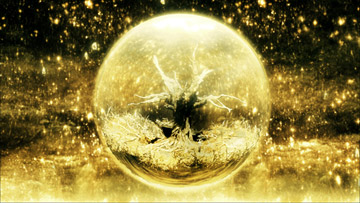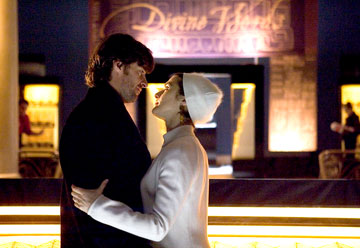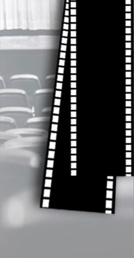Rating
-

Cast & Crew
info:
Drama/Romance (US); 2006; Rated PG-13
for some intense sequences of violent action, some sensuality
and language; Running Time: 96 Minutes
Cast
Hugh Jackman
Tomas/Tommy/Dr. Tom Creo
Rachel Weisz
Queen Isabel/Izzi Creo
Ellen Burstyn
Dr. Lillian Guzetti
Mark Margolis
Father Avila
Stephen McHattie
Grand Inquisitor Silecio
Produced by
Arnon Milchan, Iain Smith and Nick Wechsler;
Directed and written by Darren Aronofsky; based
on the story by Darren Aronofsky and Ari Handel
Official
Site
Domestic Release Date:
November 22, 2006
Review Date
07/01/07
|
 Written
by DAVID M. KEYES Written
by DAVID M. KEYES
The
director who undertakes ventures that are about more than
conventional entertainment value is the director who goes
on to make a movie like “The Fountain,” in which
message and concept are bound by touches of experiment in
a way that lends great potential to the way a story can
move, excite and intrigue us on more than just a surface
level. The very existence of the movie is a refreshing notion,
a manner made all the more exhilarating by the sheer gustiness
of its thrust, and its ability to turn its own nose up at
the idea of attracting a crowd interested only in traditional
thrills. But the Hollywood machine often forgets that it
inherits its most faithful of followers not from the mainstream,
but rather from the trenches in which many a unique cinematic
endeavor reside. It is this prospect, alas, that encourages
many of the most gifted and offbeat filmmakers to simply
abandon the more challenging road and move onto the path
more glamorous. What happened to the era of the movies where
we went to think, to learn, and to experience? And for that
matter, what happened to the times in which we embraced
the eccentrics for what they were, and not for how much
box office potential their movies had? There are those of
course who find great success in making that leap, but for
most the grass is seldom greener on the other side of the
fence.
A sad state of the movie world indeed, but not one that
is entirely bleak either. For every Tim Burton that leaps
from the cliff and finds no cushion beneath his feet, there
is a Darren Aronofsky who seems perfectly content staying
in the backwoods, making movies in the process that are
not only about people, but also about feelings, about humanity
and synergy, and about the harsh realities they attempt
to survive in. His latest effort follows 2000’s “Requiem
for a Dream,” the stark and heart-breaking chronicle
of four people who allow themselves to be destroyed from
the inside by measures that most would see as relatively
preventable. In both movies, characters marinate in a cesspit
of melancholy and despair, many times teetering along the
edge of downright obsession. The push comes in different
forms; for those in “Requiem” it emerges as
drug dependency, for the hero in “The Fountain”
it comes out as a pursuit of something too far out of reach
to seem tangible, yet too desired to be abandoned.
The difference between it and “The Fountain”
lies entirely in technique. This movie is non-linear, sometimes
intensely abstract; its three arcs overlap one another,
only one of them being grounded (the other two either exist
as echoes of the former, or merely abandoned outlines of
it for the sake of provoking dialogue on how different time
periods and realities can shape universal goals). In the
primary narrative, Hugh Jackman plays Dr. Tom Creo, a brilliant
mind of medicine who spends night and day in dimly-lit laboratories
searching for answers – or rather, a result –
in the most important and time-sensitive project of his
life: finding the cure to his wife’s bout with terminal
brain cancer.
She (played her with great subtlety by Rachel Weisz) is
a woman at peace with her fate, a soul cherishing the time
she has left; he, on the flip side, is an obsessed and fool-hearted
man, so driven by his refusal to deal with fate that his
own obsession feels almost terminal in itself. His drive
is misguided, his spirit is drained, and his efforts are
pointless. Or are they? To wonder is to acknowledge that
this is a doctor who obviously lives in an alternate reality,
one where the rules remain the same but guidelines are bendable,
perhaps even breakable. Who really is to say that his efforts
cannot lead to a breakthrough? Is it really all that hopeless?
The anchored answers in our minds have a tendency to be
challenged because we want them to, perhaps because we are
optimists who secretly hope that solutions to the biggest
problems in life are not unattainable, just temporarily
out of reach.
 The Fountain of Youth is a relic that few in the movie-making
business seem eager to pursue as a plot device – with
the introduction of it comes incessant moral and spiritual
dilemmas, a fact that is demonstrated to full force in this
utterly rich and impassioned gem of a film. Most directors
would dilute the questions it raises by making it trivial
or even background; here, Aronofsky allows the subtext of
it to absorb his stories and their characters. It is saturated
with heart and driven by mind, complex and thought-provoking
in the way it allows threads of argument and reason to weave
themselves through the elaborate psyches that populate the
celluloid. Its effect is further enriched by a visual style
that is intricate and zealous and yet not overly glossy;
never do you suspect that it exists just for the sake of
attracting those who are into movies just for special effects
or set design. The script does not base all the questions
it raises on answers either, a factor that is encouraging
as a viewer (finally, at long last, a moviemaker trusts
us to make our own decisions about a theme being presented).
The Fountain of Youth is a relic that few in the movie-making
business seem eager to pursue as a plot device – with
the introduction of it comes incessant moral and spiritual
dilemmas, a fact that is demonstrated to full force in this
utterly rich and impassioned gem of a film. Most directors
would dilute the questions it raises by making it trivial
or even background; here, Aronofsky allows the subtext of
it to absorb his stories and their characters. It is saturated
with heart and driven by mind, complex and thought-provoking
in the way it allows threads of argument and reason to weave
themselves through the elaborate psyches that populate the
celluloid. Its effect is further enriched by a visual style
that is intricate and zealous and yet not overly glossy;
never do you suspect that it exists just for the sake of
attracting those who are into movies just for special effects
or set design. The script does not base all the questions
it raises on answers either, a factor that is encouraging
as a viewer (finally, at long last, a moviemaker trusts
us to make our own decisions about a theme being presented).
There might have been more of an incentive to make the three
overlapping stories more direct and to-the-point in a situation
where the screenplay chose to make an exact conclusion about
the material, but the general ambiguity of it adds to the
resonance. As viewers we are quick to draw on the drama
and heartbreak that infests the lives of these two soul-bound
lovers, but from the analytical side of things the attempt
to decipher the other two semi-narratives represents a challenge
too delicious to ignore. Jackman and Weisz are right on
target as man and wife but even more intriguing as queen
and warrior, two souls who cross paths – but are never
meant to be connected – in 15th century Spain. Queen
Isabel faces certain death at the hands of sworn enemies,
but the lustful and dedicated eyes of Tomas, her trusted
guard, refuse to let that be, and the strong man makes a
perilous journey into the unknown for the answer to her
(and maybe his) immortality. Perhaps even greater a contrast
to that is the third story, a vignette that is haunting
in its quietness as we watch Jackman, now a monk of sorts,
attempting to save the spirit of a dying tree by taking
it to a nebula for rejuvenation.
The perplexity of it all is relentless. Are Jackman and
Weiss two souls repeating history across time, reincarnated
for the sake of learning from the past? Are the stories
blending into one another because only one is happening
and the other two are illusions, or even figments in alternate
realities? If finding the direct links proves to be too
great a stretch, it is perhaps safer to look at the triangular
story arc from a more mechanical approach. Here we have
similar ideas, similar paths and similar fates playing out
on three canvases each fueled by different stages of the
creative process: the vague and uncertain (Tom and his Tree),
the adventurous and stark (Tomas and his Queen), and the
fully realized (Tom and his dying wife). If one is to be
left with anything for certain at the end of “The
Fountain,” it is the unmatched realization that its
creator is fully in love with not just the result of his
art, but also the very happening of it. Here we have a man
who has a lot to say and only a couple hours to say it,
and instead of filling our heads with long and exhausting
diatribes in which exact positions are taken, he creates
a multi-faceted universe that is quiet and subtle enough
with its points to warrant long and involved discussions.
© 2007, David Keyes, Cinemaphile.org.
Please e-mail the author here
if the above review contains any spelling or grammar mistakes. |




